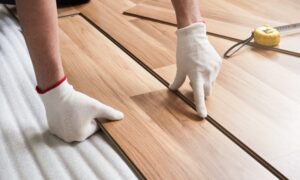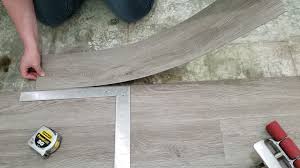Are peel and stick tiles waterproof? That’s a question many homeowners ask when considering this popular flooring option.
Well, hold onto your hats because we’re about to dive into the world of peel and stick tiles like a team of determined explorers.
In this article, we’ll unravel the mysteries surrounding waterproofing in these tiles, explore the factors that affect their water resistance, and provide expert tips on how to determine if they are truly waterproof.
So grab your snorkels and let’s get started!
Key Takeaways Are Peel and Stick Tiles Waterproof
- Peel and stick tiles are not automatically waterproof and it is essential to consider the specific product and its suitability for wet areas.
- Waterproofing is crucial for protecting against water damage, cracks, and warping, as well as preventing the growth of mold and mildew.
- Factors such as the type of adhesive used, surface preparation, temperature, and humidity can affect the waterproofing of peel and stick tiles.
- Regular maintenance is required to prevent buildup or mold growth, and careful placement of heavy objects is necessary to avoid lifting or damage.
The Basics of Peel and Stick Tiles
Peel and stick tiles are a popular choice for homeowners due to their easy installation and low maintenance requirements. Understanding the installation process can help ensure a successful project.

First, it’s important to have a clean and smooth surface before applying the tiles. This can be achieved by removing any existing flooring or debris, and using a primer if necessary.
Once the surface is prepared, simply peel off the backing of each tile and stick it onto the floor. The adhesive on the back of these tiles allows for quick and secure placement.
One of the benefits of peel and stick tiles is that they can be easily replaced if damaged or worn out. Additionally, they are often water-resistant, making them suitable for areas like bathrooms or kitchens where moisture may be present.
Overall, understanding how to properly install peel and stick tiles can result in a beautiful and durable flooring option for any home.
Understanding Waterproofing in Tiles
When it comes to tiles, it’s important to understand their waterproofing capabilities. Waterproofing techniques play a crucial role in ensuring that the tiles can withstand moisture and water damage. Here are some key points to help you appreciate the benefits of waterproof tiles:

- Increased durability: Waterproofing helps protect the underlying structure of the tile from water damage, preventing cracks and warping.
- Mold and mildew resistance: Proper waterproofing prevents moisture from seeping into the tile, reducing the growth of mold and mildew.
- Easy maintenance: Waterproof tiles are easier to clean as they repel water, making them less prone to stains.
Understanding waterproofing techniques is essential for choosing the right tiles for your space.
Now let’s explore factors affecting the waterproofing of peel and stick tiles.
Factors Affecting the Waterproofing of Peel and Stick Tiles
One important factor to consider for the waterproofing of peel and stick tiles is the type of adhesive used. The adhesive plays a crucial role in ensuring that the tiles adhere securely to the surface, preventing water from seeping through. Factors affecting adhesion include surface preparation, temperature, and humidity levels during installation.

Properly cleaning and priming the surface before installing the tiles is essential for optimal adhesion. Temperature and humidity can also impact how well the adhesive bonds with both the tile and the surface.
Additionally, using waterproof peel and stick tiles offers several benefits. They provide a durable and long-lasting solution for areas prone to moisture such as bathrooms or kitchens. Moreover, these tiles are easy to install, making them a convenient option for homeowners looking to upgrade their space without extensive renovations.
How to Determine if Peel and Stick Tiles Are Waterproof
When it comes to determining if peel and stick tiles are waterproof, two key points to consider are the water resistance test and the manufacturer’s product specifications.
The water resistance test involves applying water to the surface of the tile and observing if it beads up or is absorbed. This can give an indication of how well the tile will hold up against moisture.
Additionally, checking the manufacturer’s product specifications can provide valuable information about whether or not the tiles are designed to be used in wet areas such as bathrooms or kitchens.
Water Resistance Test
To test the water resistance of peel and stick tiles, you can simply pour water on them and see if they repel it or absorb it. Here are some important points to consider when testing the water resistance of these tiles:
- Waterproofing techniques:
- Peel and stick tiles are designed to be resistant to water, but they may not always be completely waterproof.
- Some manufacturers offer additional waterproofing techniques such as using a sealant or applying a waterproof membrane before installing the tiles.
- It is important to follow the manufacturer’s instructions for proper installation and maintenance.
- Long-term water exposure:
- While peel and stick tiles may resist short-term water exposure, prolonged exposure to standing water can cause damage over time.
- The quality of the adhesive used in the tiles plays a crucial role in their ability to withstand long-term water exposure.
- Regular inspection and maintenance are recommended to ensure that any potential issues with water penetration are addressed promptly.
Manufacturer’s Product Specifications
In addition to the water resistance test, it is important to examine the manufacturer’s product specifications when determining if peel and stick tiles are waterproof. These specifications outline the waterproofing techniques used in the manufacturing process and provide valuable information about the advantages of using waterproof tiles.
To make it easier to understand, let’s take a look at a table that highlights some key features of waterproof tiles:
| Waterproofing Techniques | Advantages of Waterproof Tiles |
|---|---|
| Multiple layers of protection | Resistant to water damage |
| Tight seams and joints | Prevents water leakage |
| Water-resistant adhesive | Ensures long-lasting bond |
| Non-porous surface | Easy to clean and maintain |
| Suitable for wet areas | Perfect for bathrooms and kitchens |
Common Misconceptions About Peel and Stick Tiles and Waterproofing
When it comes to waterproofing peel and stick tiles, there are a few common misconceptions that need to be addressed.
Firstly, many people assume that all peel and stick tiles are automatically waterproof, but this is not always the case. It’s important to understand the specific product you are using and whether or not it has been designed for wet areas such as bathrooms or kitchens.
Additionally, while stick-on tiles can be a convenient and cost-effective option for flooring, their durability can vary depending on factors such as the quality of the adhesive used and the amount of foot traffic they will endure.
Waterproofing Peel and Stick
Did you know that peel and stick tiles are waterproof? It’s true! These versatile tiles offer a convenient and affordable option for achieving a waterproof surface in various areas of your home.
Here are some key points to help you understand the benefits and considerations of using peel and stick tiles for waterproofing:
- Easy Installation: Peel and stick tiles can be effortlessly applied to any clean, dry surface, making them a hassle-free solution for achieving waterproofing.
- Durability: These tiles are designed to withstand moisture and provide long-lasting protection against water damage.
- Versatility: Peel and stick tiles come in a wide range of styles, colors, and patterns, allowing you to choose an option that suits your aesthetic preferences.
When it comes to waterproofing methods, peel and stick tiles offer a practical alternative to traditional tile options. They provide an effective barrier against water while offering ease of installation and versatility in design.
Whether you’re looking to update your bathroom or renovate your kitchen backsplash, consider using peel and stick tiles as an efficient way to achieve waterproof surfaces.
Durability of Stick-On Tiles?
The durability of stick-on tiles is a key consideration for homeowners seeking long-lasting protection against water damage. When it comes to waterproofing, durability concerns are crucial in ensuring the long-term effectiveness of peel and stick tiles.
These tiles are designed to provide a barrier against moisture, preventing water from seeping through and causing damage to underlying surfaces. To ensure their longevity, manufacturers use high-quality materials that are resistant to water and wear. The adhesive used in these tiles is specifically formulated to withstand moisture and remain firmly attached over time.
Additionally, many brands offer peel and stick tiles with additional protective layers, such as a waterproof coating or an extra thick wear layer, further enhancing their durability and long-term waterproofing effectiveness.
It’s essential for homeowners to choose reputable brands that prioritize durability in their products to ensure maximum protection against water damage in the long run.
Pros and Cons of Waterproof Peel and Stick Tiles
You’ll want to consider the pros and cons of waterproof peel and stick tiles. These tiles are specifically designed to resist water, making them a great option for areas prone to moisture, such as bathrooms and kitchens.
Here are some key points to consider:
- Advantages of Waterproof Peel and Stick Tiles:
- Easy Installation: These tiles can be easily installed without the need for professional help.
- Durability: Waterproof peel and stick tiles are more resistant to water damage compared to water-resistant ones.
- Versatility: They come in various styles, colors, and patterns, allowing you to achieve your desired aesthetic.
- Disadvantages of Waterproof Peel and Stick Tiles:
- Cost: Compared to regular peel and stick tiles, waterproof versions tend to be pricier.
- Limited Application Range: While these tiles work well in moisture-prone areas, they may not be suitable for outdoor use or extremely wet environments.
- Maintenance Requirements: Regular cleaning is essential to prevent any buildup or mold growth on the surface.
Considering these aspects will help you make an informed decision when choosing between waterproof vs. water-resistant peel and stick tiles.
Tips for Maintaining Waterproof Peel and Stick Tiles
To maintain your waterproof peel and stick tiles, it’s important to regularly clean and prevent any buildup or mold growth on the surface. By doing so, you can ensure that the adhesive bond remains strong and the tiles stay in place for a long time.
Start by sweeping or vacuuming the floor to remove any loose dirt or debris. Then, use a mild detergent mixed with warm water to mop the tiles, making sure not to oversaturate them. Avoid using harsh chemicals or abrasive scrubbers as they can damage the surface of the tiles.
Additionally, be cautious when placing heavy objects on top of the tiles as excessive weight can cause them to lift or become damaged.
Waterproofing Options for Non-Waterproof Peel and Stick Tiles
Now that we’ve discussed tips for maintaining waterproof peel and stick tiles, let’s explore some waterproofing options for non-waterproof peel and stick tiles.
While these tiles may not be inherently waterproof, there are techniques you can use to make them more resistant to water damage. Here are some alternatives and techniques to consider:
- Waterproof sealants: Applying a layer of waterproof sealant over the non-waterproof tiles can help create a barrier against moisture.
- Epoxy grout: Using epoxy grout instead of regular grout can provide additional protection as it is less porous and more resistant to water penetration.
- Tile primers: Applying a tile primer before installing the peel and stick tiles can enhance their water resistance.
Expert Advice on Waterproofing Peel and Stick Tiles
By seeking expert advice, you can receive valuable insights on how to enhance the water resistance of your peel and stick tile installations.
There are various waterproofing methods available that can help make your peel and stick tiles more resistant to water damage. One popular method is applying a waterproof membrane or sealant over the tiles to create a barrier against moisture. This can prevent water from seeping through the seams or edges of the tiles, ensuring they remain in good condition for longer periods.
Another option is using waterproof peel and stick tiles that are specifically designed to withstand moisture. These tiles have special coatings or materials that make them highly resistant to water damage, offering additional benefits such as easy maintenance and durability.
Seeking expert advice on these methods will ensure you choose the best solution for your specific needs.
To further illustrate the effectiveness of waterproof peel and stick tile installations, let’s explore some real-life examples in the subsequent section.
Real-Life Examples of Waterproof Peel and Stick Tile Installations
When it comes to successful waterproof tile installations, there are a few key points to keep in mind.
First and foremost, proper preparation is essential. This includes ensuring a clean and dry surface, as well as using the right adhesive for your specific tiles.
Additionally, applying a waterproofing membrane before laying the tiles can provide an extra layer of protection against moisture.
In terms of application tips, making sure to follow the manufacturer’s instructions and allowing ample drying time is crucial for achieving a long-lasting and water-resistant finish.
Successful Waterproof Tile Installations
To ensure successful waterproof tile installations, it is crucial to properly prepare the surface before applying peel and stick tiles. This step helps prevent water damage and moisture-related issues in the future.
Here are some key techniques and materials to consider:
- Surface Preparation:
- Clean the surface thoroughly to remove dirt, dust, or grease.
- Repair any cracks or uneven areas on the surface.
- Ensure that the surface is smooth and dry before proceeding with tile installation.
- Waterproofing Techniques:
- Apply a waterproofing membrane or primer to create a barrier against moisture.
- Use waterproof grout or sealant around the edges of the tiles for added protection.
- Waterproofing Materials:
- Opt for peel and stick tiles that have a built-in waterproof layer.
- Consider using adhesive or caulk specifically designed for wet environments.
Waterproof Tile Application Tips
Now that we’ve discussed successful waterproof tile installations, let’s delve into some essential tips for maintaining and maximizing the benefits of waterproof tiles.
Proper tile maintenance is crucial to ensure their longevity and performance. Regular cleaning with mild detergent and warm water will help remove dirt and grime without damaging the surface. Avoid using harsh chemicals or abrasive cleaners that can erode the protective layers of the tiles.
Additionally, it’s important to promptly clean up any spills or stains to prevent them from penetrating the tile’s surface. The benefits of waterproof tiles extend beyond just their resistance to water damage. They also offer easy installation, durability, and a wide range of design options.
Frequently Asked Questions
Can I Use Peel and Stick Tiles in a Bathroom Shower?
Yes, you can use peel and stick tiles in a bathroom shower. They are waterproof and durable, which makes them suitable for wet areas like kitchens and bathrooms.
How Long Do Peel and Stick Tiles Typically Last in Wet Environments?
Peel and stick tiles typically last about 5-10 years in wet environments. However, it’s important to note that their durability can vary depending on factors such as the quality of the tiles and proper installation.
Can I Install Peel and Stick Tiles on Top of Existing Waterproof Flooring?
Yes, you can install peel and stick tiles on concrete. They are a great option for basement flooring because they are easy to install and can withstand moisture when applied correctly.
Are Peel and Stick Tiles Suitable for Outdoor Use?
Peel and stick tiles are not recommended for outdoor installation due to their lack of durability in rain. However, they can be a great option for indoor use as they are easy to install and require minimal maintenance.
What Happens if Water Seeps Through the Seams of Peel and Stick Tiles?
If water seeps through the seams of peel and stick tiles, it can cause water damage to the underlying surface. To prevent this, ensure proper installation and use a waterproofing sealant. Regular maintenance is also important to avoid any potential issues.
Conclusion
In conclusion, peel and stick tiles can be waterproof. However, their waterproofing capabilities are influenced by several factors. These factors include the quality of the adhesive, the material of the tile, and proper installation techniques. By considering these factors, you can ensure a water-resistant surface that can withstand moisture and humidity. It is important to note that regular maintenance is necessary to preserve the waterproof properties of the tiles. Therefore, investing in high-quality peel and stick tiles is a wise choice for a beautiful and durable waterproof flooring solution. As the saying goes, ‘Water off a duck’s back!’




